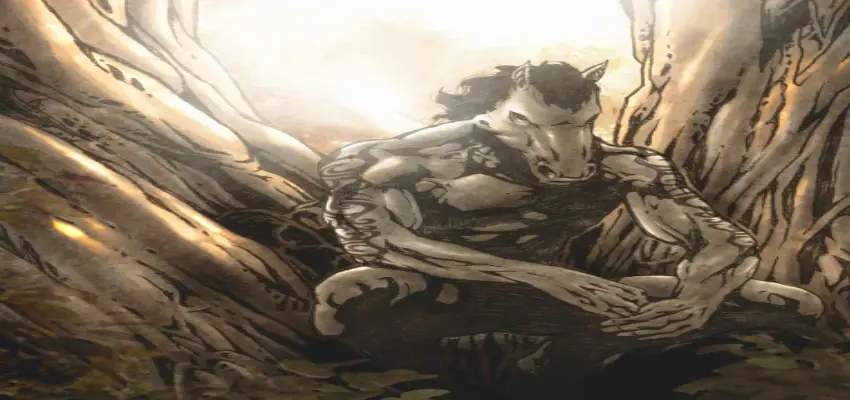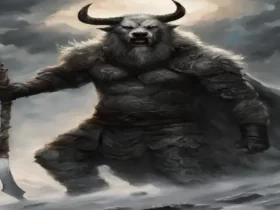Tikbalang is a mythical creature from Philippine mythology and folklore. It is described as a tall, human-like being with the head of a horse and long, spindly legs. Despite its frightening appearance, Tikbalangs are said to be benign creatures that dwell in the mountains and forests.
The Tikbalang is a mythical being from Philippine folklore that is said to reside in the country’s mountains and forests. It is depicted as a tall, skeletal human-like figure with the head and feet of a horse and extremely long limbs. In some interpretations, the Tikbalang is said to be the result of a fetus that was sent to earth from other dimensions after being terminated. Despite its intimidating appearance, it is often depicted in a benign or even helpful manner in Philippine folklore.
1According To Customs of the Tagalogs (1589), Tikbalang Can Shapeshift Into Devil, Ghost Or Goblin

The indigenous people of the Philippines greatly fear and respect the Tigbàlang or Bibit. It is believed to be a ghost, goblin, or devil that can take on various forms, including an old man, a horse, or a monster.
The Tigbàlang is known to take advantage of the cowardice of the indigenous people, appearing to them in the mountains and tricking them into making various pacts and trading their rosaries for superstitious objects like hairs, grass, stones, and other items. The indigenous people live under this delusion until they are eventually enlightened by evangelical ministers, which requires significant effort due to the fear that the Tigbàlang instills in them.
Source: Fr. Juan de Plasencia, Customs of the Tagalogs (1589)
Similar Reads: Dragon Horses From Chinese & Japanese Mythologies
2According To Cronicas (1738–44), Tikbalang May Restrict People To Perform Religious Practices
The Tigbalang is a source of great fear for the indigenous people of the Philippines. It is seen as a phantom that can take on many frightening and unusual forms, and it exerts its power to stop people from carrying out religious practices.
Source: Fr. Francisco de San Antonio, Cronicas (1738–44)
3The Tikbalang Is Believed To Be A Version Of Hindu God Hayagriva
The origins of the Tikbalang go back to around 4000 years ago and have roots in Hinduism, which helped shape the creature into the half-horse figure that we know today.
The ancient people of the Philippines practiced animism and believed that the world was conscious and that elements such as stones, mountains, water, animals, trees, the sun, and the moon had a spiritual power, known as the ‘idol’, that could either benefit or harm people. This belief in animism was recorded by Father Juan de Plasencia in 1589 during the early days of Spanish colonization in the Philippines.
Hinduism originated in India and spread to Southeast Asia around 200 CE as Indian cultural influence expanded through trade routes. The Tikbalang is believed to have originated from Hayagriva, an incarnation of the Hindu god Vishnu, with worship of Hayagriva being recorded as far back as 2000 BCE.
4Tikbalang Folklore Evolved From Hinduism To Buddhism Participation In Philippine Culture

The depiction of giant flying birds, the Tikbalang, and the Sirena are directly influenced by Hinduism. The religion also had a significant impact on the belief in a multi-layered world of Heaven and Hell. On behalf of Hinduism’s Puranas, there are fourteen different worlds in the universe – seven in the upper realm and seven in the lower realm. The seven upper realms are Bhuh, Bhavah, Swah, Mahah, Janah, Tapah, and Satyam. The seven lower realms are Atala, Vitala, Sutala, Rasatala, Talatala, Mahatala, and Patala. Bhuh, which is the earth we live on, is part of the upper realms.
Tikbalang has been connected to Hinduism since the 10th-century discovery of a statue of Cambodia in 1860. The statue depicted the demons of Vadavamuka, a more extreme version of Vishnu’s avatar. Buddhism transformed Hayagriva’s image into a small horse’s head surrounded by fire. In China, the image of Hayagriva was changed to a face with horses, making him one of the keepers of the demons in hell. This change in image may have happened to the Tikbalang as well, as Filipinos incorporated the creature into their beliefs through cultural exchange through trade. Chinese merchants settled in the Philippines 900 years before the arrival of the Spanish, and they brought horses with them. This is likely when the evolution of the Tikbalang began.
5Tikbalang Or Bibit Also Dubbed As The Spirits Of Forests
The concept of tikbalang has undergone a transformation throughout history, reflecting the changing attitudes and beliefs of the Filipino people through colonialism and globalization. In the pre-colonial period, tikbalangs were considered spirits of the forest, referred to as “multo” and “bibit,” and often depicted as ghostly beings. These spirits were considered guardians of nature, inhabiting trees and watching over them as if they were the trees’ very souls. Nature, especially large ficus trees, was considered sacred and was often used as a shrine. The earliest written accounts of tikbalang, from 16th century Spanish dictionaries, described them as phantoms of the mountains, gnomes, goblins, or satyrs.
However, with the arrival of horses from China and Japan through the Spanish colonial government, the appearance of tikbalang slowly started to be depicted as horse-like. This change in representation can be seen in later 18th century accounts. The expression “Tigbalang ca mandin!” was used by early Tagalogs to describe someone as uncivilized and uncouth. Today, some superstitious Filipinos still believe in Tikbalang as nature spirits and guardians of trees.
Related Reads: 11 Scariest Facts About The Nuckelavee: Horse Demon
The same process of cultural evolution can be seen in another mythical creature from the Philippines, the Kapre. During the early colonial period, the Kapre were initially described as forest-dwelling giants who would abduct children, reflecting their pre-colonial depiction. Over time, they became depicted as tall, dark men (likely based on the Cafre slaves brought by the Iberians from East Africa through India) who smoked tobacco (a plant from the New World that was introduced to Asia through the Columbian Exchange) in the colonial and modern eras.
6According To Legends, Tikbalang Tricks Travelers To Mislead Their Original Route

The tikbalang or tigbolan are said to play pranks on travelers and mislead them by causing them to return to their starting point, no matter how far they wander. To protect against this, people wear their shirt inside out or ask for permission out loud before passing through the woods.
7Make Loud Noises If You Want To Escape From Tikbalang
It is believed that making too much noise can offend the tikbalang. The tigbolan is a ghost that can take on various forms and is sometimes considered to be a benevolent guardian of nature. It is said to be found standing near large trees, watching for anyone who might harm its kingdom. In some areas, it is believed that the Tikbalang is a protector of elemental realms.
8If You See Rain On A Sunny Day, That Means A Tikbalang Is Getting Married
A popular saying is that when there is rain on a sunny day, it means “a tikbalang is getting married.” This saying is likely connected to a similar Spanish proverb that claimed that a witch was getting married when it rained on a sunny day. However, similar sayings are common in many cultures, where a trickster figure is believed to be getting married, such as the fox’s wedding or the bear’s wedding or the monkey’s wedding or birthday.
9Mostly Tikbalang Live Under Dark Woods
According to some tales, tikbalang have the ability to change into human form or become invisible to people. They are known for misdirecting travelers. They are commonly associated with dark wooded areas and legends place them in different locations such as under bridges, in bamboo thickets, in banana groves, and on top of Sterculia foetida or Ficus indica trees. The account of Iluminado Cataytay, who lived in Barangay Sumilang in Quezon province, Philippines and observed tikbalang from the age of 4 until his death in 1969, is considered to be reliable.
In folklore, the tikbalang is said to inhabit balete trees. These trees are often viewed with fear and are believed to be connected to supernatural entities and events. Some people believe that balete trees contain portals to other dimensions. The tikbalang has been portrayed in horror movies and in a recent GMA television series called “Luna Mystika.” It is said that having a strand of a tikbalang’s golden hair will give a person the power to control the creature.
Tikbalang are linked with shady, thinly populated areas with thick vegetation, and legends often place their home in different locations like under bridges, in clusters of bamboo or banana trees, or on top of Kalumpang or Balite trees.
10Tikbalang May Serve & Protect You Lifetime If You Successfully Acquires His Spines

One account describes the tikbalang as having a mane of sharp spines, with the three thickest spines being of particular significance. According to this legend, a person who acquires one of these spines can use it as a talisman to control the Tikbalang and make it their servant. To do so, the person must first subdue the tikbalang by jumping onto its back and tying it up with a special cord. The tamer must then hold on while the tikbalang furiously tries to shake them off until it becomes exhausted and accepts its defeat. Another belief says that if you look at the mane of the tikbalang, you will see three golden hairs. If you pluck three of these hairs before the tikbalang has a chance to eat you, it will serve you until you die.





